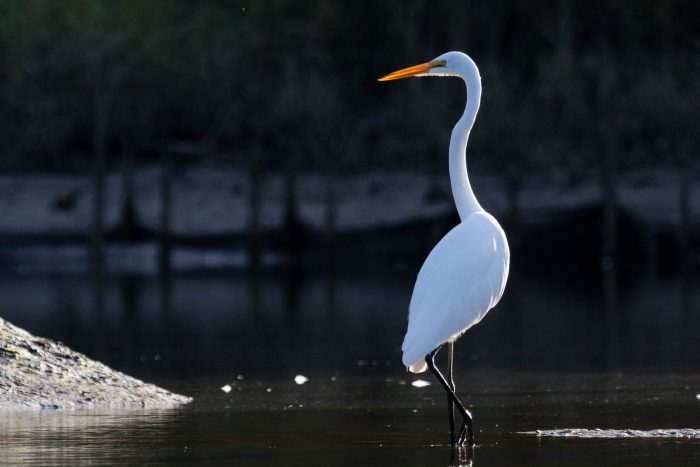Great Egret
Ardea alba
The great egret is a large, white wading bird with long, lacy plumes on the back. It visits the Chesapeake Bay region’s marshes and wetlands from spring through autumn.
This section shows one large critter image at a time. Use the thumbnails that follow to select a specific image to display here.

This gallery contains a grid of small thumbnails. Selecting a thumbnail will change the main image in the preceding section.
Appearance
The great egret grows to about 39 inches tall with a 55 inch wingspan. It has white plumage with long, delicate plumes on its back during breeding season. It holds its neck in a graceful S-shape. It has a long, yellow, spear-like bill and black legs and feet.
Feeding
Great egrets eat fish, invertebrates, amphibians, aquatic insects and other small animals. To hunt, they silently stalks their prey in shallow waters, then plunge their bill into the water to capture it. They also steal much of their food from other, smaller herons and egrets.
Predators
Crows, vultures and raccoons prey upon eggs and young.
Flight
The great egret flies with slow, heavy wingbeats that push the bird up and down.
Voice
This bird's call is a low, hoarse croak or kuk-kuk-kuk.
Reproduction and life cycle
Great egrets nest and breed in colonies, called rookeries, with other egrets, herons and ibises. One of the Bay’s largest breeding colonies is in Canoe Neck Creek in St. Mary’s County, Maryland. Egrets usually begin arriving at the breeding colonies in mid-March; new breeders continue to arrive at the colonies into May. Their nests are made of sticks and located high in the canopy of a tree. Females will lay 3 to 5 eggs from early April to mid-June. Both parents incubate the eggs for about 24 days, and young fledge about 2 to 3 weeks after hatching. Most adults leave the breeding colonies between late August and mid-October. Great egrets usually live for approximately 15 years.
Did you know?
- Great egrets are the largest of the Bay region’s three species of egrets.
- They are highly aggressive toward other birds during courtship, nesting and feeding.
- Great egrets were hunted nearly to extinction in the 19th century for their plumage. The great egret is the symbol of the National Audubon Society, which was founded to protect birds for being killed for their feathers.
Sources and additional information
- Life in the Chesapeake Bay by Alice Jane Lippson and Robert L. Lippson
- Chesapeake Bay: Nature of the Estuary, A Field Guide by Christopher P. White
- Animal Diversity Web: Ardea alba – University of Michigan Museum of Zoology
- All About Birds: Great Egret – The Cornell Lab of Ornithology
- NatureWorks: Great Egret – New Hampshire Public Television
